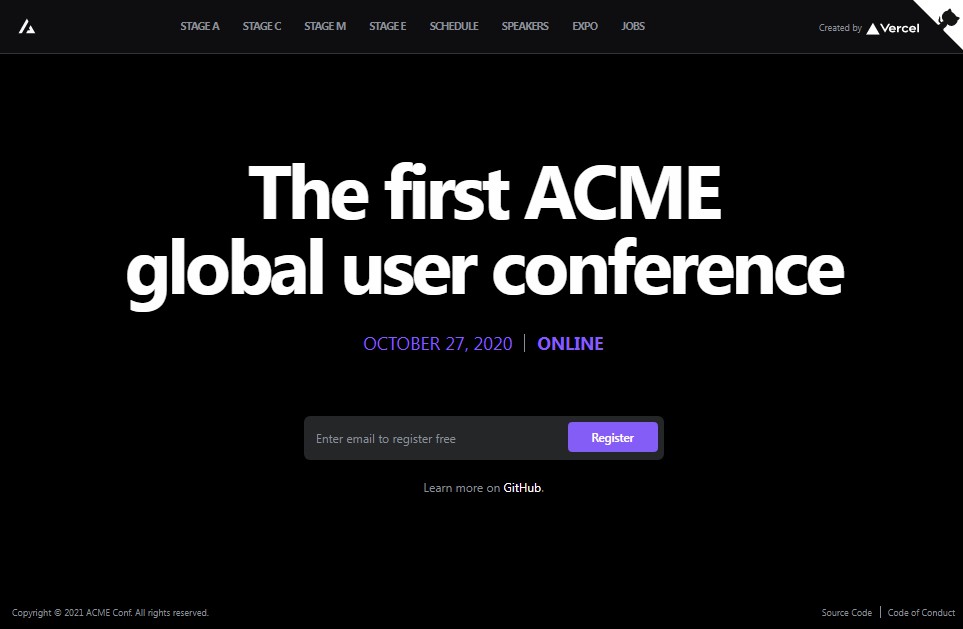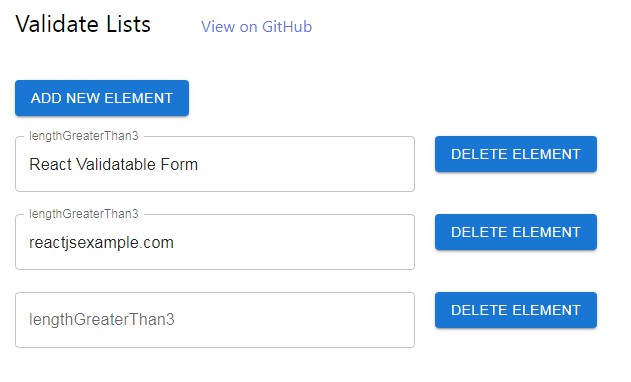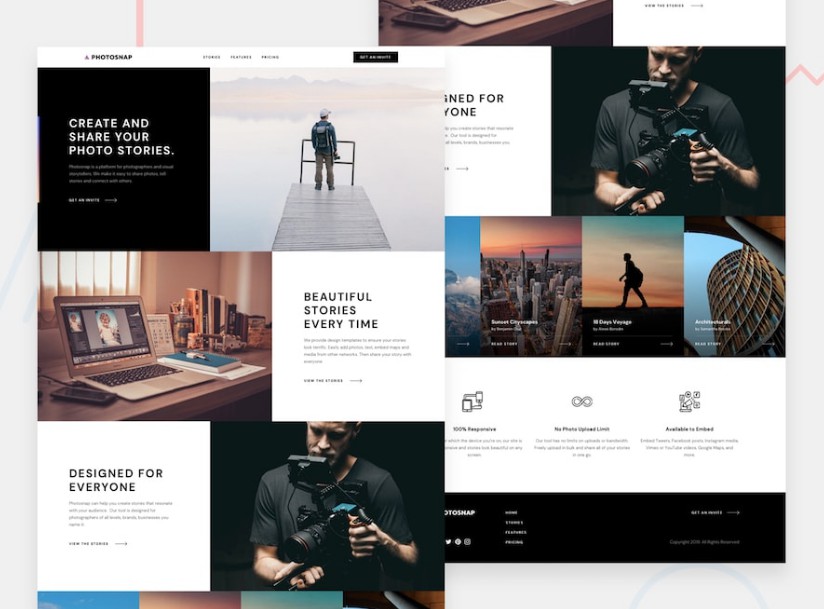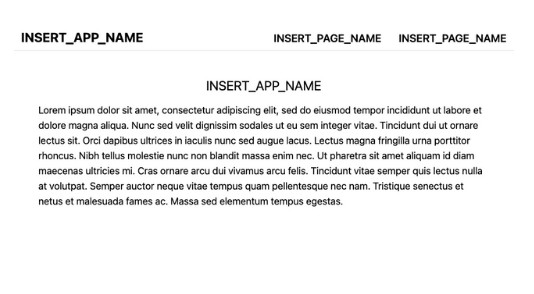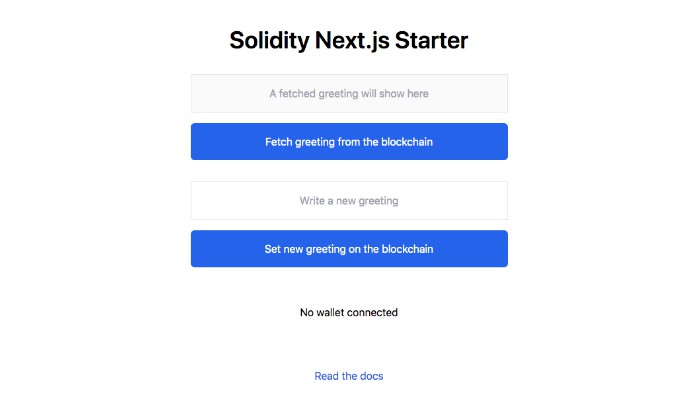Virtual Event Starter Kit
Demo: https://demo.vercel.events
This virtual event starter kit was used to run Next.js Conf 2020, which had almost 40,000 live attendees. It includes the following features:
- Multiple stages with an embedded YouTube stream
- Sponsor expo, including individual virtual booths
- Career Fair, allowing attendees to network and find job opportunties
- Ticket registration and generation
- Speaker pages and bios
- Schedule
This platform is built upon three principles:
- Delegation: Running a conference is difficult – you have to delegate tasks to third-parties to ensure success. Certain elements of an online conference experience are tough to get right, and we’d rather lean on established, industry leading solutions.
- Flexibility: While delegating certain elements of the conference experience is helpful, it’s also important to own the platform. That’s why this template provides a flexible open-source codebase that can be modified for your event.
- Reducing Risk: It’s inevitable something will go wrong during your event. This platform reduces risk by leaning on a dynamic site that outputs as static files using Incremental Static Generation. These static files are cached, ensuring your site is never down. Then, it uses API Routes to sprinkle dynamic content on top, which are hosted by a provider with 99.99% uptime.
Built With
- Framework: Next.js
- CMS: Multiple Options
- Videos: YouTube
- Deployment: Vercel
- Authentication: GitHub OAuth
- Database: Redis
Running Locally
First, set local environment variables. We’ve included a read-only DatoCMS access token you can use in .env.local.example.
cp .env.local.example .env.local
Then install packages and run the development server:
yarn install
yarn dev
Open http://localhost:3000 with your browser to see the result.
Clone and Deploy
Click the button below to clone and deploy this template on Vercel.
You’ll be asked to install the DatoCMS integration. It lets you sign up or log in to DatoCMS and create a new DatoCMS project based on the data (speakers, stages, etc.) used in the demo.
Customize
CMS
Environment variables determine which CMS to use. See lib/cms-api.ts for details and .env.local.example for all environment variables. The demo (demo.vercel.events) uses DatoCMS, but we also have support for:
- Agility
- Contentful
- Prismic (Instructions)
- Sanity
- Storyblok
- Click the following link to create the space for this starter kit in Storyblok: Create Event Space
Constants
lib/constants.ts contains a list of variables you should customize.
Authentication and Database
Some features won’t work until you set up authentication and database. The demo (demo.vercel.events) uses GitHub OAuth for authentication and Redis for database. You can use different providers as you see fit.
Authentication
You need to have GitHub OAuth set up to be able to customize the ticket after signing up on the registration form.
First, create a GitHub OAuth application to use for authentication.
- Set Authorization Callback URL as
<your domain>/api/github-oauth - After creating the OAuth app, create a client secret.
Running Locally:
- Set the Authorization Callback URL as
http://localhost:3000/api/github-oauthon GitHub. - On
.env.local, setNEXT_PUBLIC_GITHUB_OAUTH_CLIENT_IDas the Client ID of the OAuth app. - Set
GITHUB_OAUTH_CLIENT_SECRETas the Client secret of the OAuth app. - Finally, make sure the
NEXT_PUBLIC_SITE_ORIGINenvironment variable is set ashttp://localhost:3000. This is required to get the OAuth popup to work locally. - Restart the app (
yarn dev) after editing.env.local.
Once it’s set up, sign up using the registration form on the home page (not on a stage page) and then click “Generate with GitHub”.
On Vercel:
- Set the Authorization Callback URL as
<your deployment’s URL>/api/github-oauthon GitHub. - Set
NEXT_PUBLIC_GITHUB_OAUTH_CLIENT_IDandGITHUB_OAUTH_CLIENT_SECRETon Vercel Project Environment Variables Settings for the production environment. - Edit
SITE_URLinlib/constants.tsto match your deployment’s URL (no trailing slash). - Push the code to redeploy the Project on Vercel.
Database
You need a database to save user data and enable the following features:
- Generating a unique ticket number for each email when signing up on the registration form. If DB is not set up, it’ll always be
1234. - Generating a unique ticket image or ticket URL after signing in with GitHub. If DB is not set up, each ticket image or URL will show generic data.
The demo (demo.vercel.events) uses Redis, but you can customize it to use any database you like.
Running Redis Locally
- Install Redis locally and run it.
- Specify the following in
.env.local:
REDIS_PORT=6379 # Default Redis port number
REDIS_URL=localhost
REDIS_PASSWORD=
REDIS_SSL_ENABLED=
REDIS_EMAIL_TO_ID_SECRET=foo # Come up with your own secret string
REDIS_EMAIL_TO_ID_SECRETwill be used to create a hash of the email address, which will be used for the Redis key for each user data (i.e.id:<hash>). Seelib/redis.tsfor details.
If your Redis server has SSL (TLS) encryption enabled then set REDIS_SSL_ENABLED=true
- Restart the app (
yarn dev) after editing.env.local. - In a separate terminal window, start the Next.js dev server (
yarn dev) and sign up using the registration form. - In a separate terminal window, run Redis CLI, list keys (
keys *) and inspect aid:<hash>key (hgetall id:<hash>). You should see the newly registered user.
Using Redis On Vercel
Provision your own Redis instance and set REDIS_PORT, REDIS_URL, REDIS_PASSWORD, REDIS_SSL_ENABLED and REDIS_EMAIL_TO_ID_SECRET (come up with your own secret string) on Vercel Project Environment Variables Settings for the production environment.
If you do not want to maintain a Redis server, you can use Upstash which provides Serverless Redis with a free tier.
More Details
Stages
There are four different stages included in the seed data. Feel free to add or remove these based on your schedule. Each stage requires the user to enter their email to register with the conference before entering the event. After successfully entering their email and saving the user with your database of choice, the user is able to view the embedded YouTube stream. The login state is persisted as a httponly cookie.
One major feature of the conference platform is a near real-time sync with the CMS. Every five seconds, the stage queries /api/stages to fetch the latest information from the CMS. This allows you to make changes on the fly, without the user having the refresh the page. No need for websockets.
The primary use case for this is updating the YouTube embedded URL. Next.js Conf used this to seamlessly switch between pre-recorded videos running as a live premiere, and truly live content (e.g. panels). Plus, we had a few instances where our schedule needed to be tweaked on the fly. This implementation is fault tolerant, as well. The API route is properly cached and if the CMS was to somewhow go down, it won’t break the page.
Schedule / Speaker Pages
Schedule and speaker information is hosted in the CMS. The demo (demo.vercel.events) is seeded with images from Unsplash and a placeholder schedule. Each speaker has their own page with an image, bio, social media links, and information about their talk. The schedule is also shown as a sidebar on each corresponding stage.
Sponsor Expo
If you’d like to have your event sponsored, the Expo provides a platform to showcase sponsors with:
- Their logo
- Four call-to-action links
- Embedded YouTube video
- Link to chat room (Discord)
For Next.js Conf, we created a Discord channel for each sponsor.
Career Fair
Networking is vital for in-person conferences and replicating that environment virtually poses a challege. For the Career Fair, this starter provides the ability to list job postings, as well as an external link to talk with the company’s recruiters on Discord.
Adding Discord Chat
For Next.js Conf, we used Discord for conference attendees to chat. On each stage, we showed a highlighted message from the corresponding Discord channel. If a user in our allow list used the camera emoji (?) it would show the message on the stage.
If you’d like to add similar functionality to your conference, you can use the API route below to fetch messages after creating a Discord bot. This API route is set up with the proper caching headers and ensures you won’t get rate-limited with high traffic.
import ms from 'ms';
import fetch, { Headers, RequestInit } from 'node-fetch';
import { NextApiRequest, NextApiResponse } from 'next';
interface Reaction {
emoji: { name: string };
}
interface Message {
id: string;
channel_id: string;
content: string;
timestamp: string;
author: {
username: string;
};
reactions?: Reaction[];
}
interface ReactionSelector {
id: string;
}
// After creating a bot, add the token as an environment var
const { DISCORD_BOT_TOKEN } = process.env;
// Number of seconds to cache the API response for
const EXPIRES_SECONDS = 60;
// Emoji that should be selected by a whitelisted user
// in order for this API to return the message
const EMOJI = '?';
// Whitelisted user IDs that are allowed to add the emoji to influence this API
const USERS = [
'752552204124291104' // username
];
// Discord base API URL
const API = 'https://discordapp.com/api/';
// Map of Stage names to Discord channel IDs
const CHANNELS = new Map<string, string>([
['a', '769350098697191515'],
['c', '769350352226877549'],
['m', '769350396623192074'],
['e', '769350429644685351']
]);
const api = (url: string, opts: RequestInit = {}) => {
const headers = new Headers(opts.headers);
headers.set('Authorization', `Bot ${DISCORD_BOT_TOKEN}`);
headers.set('User-Agent', 'Discord Bot (https://yoursite.com/conf, v0.1)');
return fetch(`${API}${url}`, {
...opts,
headers
});
};
async function getReactionSelectors(
channelId: string,
messageId: string,
emoji: string
): Promise<ReactionSelector[]> {
const res = await api(
`channels/${channelId}/messages/${messageId}/reactions/${encodeURIComponent(emoji)}`
);
if (!res.ok) {
throw new Error(`Failed to get message reactions: ${await res.text()} (${res.status})`);
}
return res.json();
}
async function getLatestMessageWithEmoji(
messages: Message[],
emoji: string,
usersWhitelist: string[]
) {
for (const message of messages) {
if (!message.content.trim()) {
// Empty message, ignore
// You could also filter messages here
continue;
}
for (const reaction of message.reactions || []) {
if (reaction.emoji.name === emoji) {
const selectors = await getReactionSelectors(message.channel_id, message.id, emoji);
const selector = selectors.find(r => usersWhitelist.includes(r.id));
if (selector) {
// The correct emoji was added from a whitelisted user
return { message, selector };
}
}
}
}
}
export default async function getDiscordMessage(req: NextApiRequest, res: NextApiResponse) {
const { stage } = req.query;
if (typeof stage !== 'string') {
return res.status(400).json({ error: 'Query parameter "stage" must be a string' });
}
const channelId = CHANNELS.get(stage);
if (!channelId) {
return res.status(400).json({ error: `Invalid "stage": ${stage}` });
}
const apiRes = await api(`channels/${channelId}/messages`);
let messages: Message[] = [];
if (apiRes.status !== 429 && apiRes.ok) {
messages = await apiRes.json();
}
if (apiRes.status === 429) {
const reset = apiRes.headers.get('X-RateLimit-Reset-After') || 5;
res.setHeader(
'Cache-Control',
`s-maxage=${reset}, public, must-revalidate, stale-while-revalidate`
);
}
const messageToShow = await getLatestMessageWithEmoji(messages, EMOJI, USERS);
if (!messageToShow) {
return res.status(404).json({ error: 'Could not find message with emoji' });
}
const body = {
username: messageToShow.message.author.username,
content: messageToShow.message.content,
timestamp: messageToShow.message.timestamp
};
// Set caching headers
const expires = new Date(Date.now() + ms(`${EXPIRES_SECONDS}s`));
res.setHeader('Expires', expires.toUTCString());
res.setHeader(
'Cache-Control',
`s-maxage=${EXPIRES_SECONDS}, immutable, must-revalidate, stale-while-revalidate`
);
return res.status(200).json(body);
}
Demo
The demo is available at https://demo.vercel.events. The data recorded or used on the demo may be removed by Vercel at any point.
